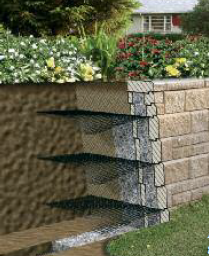Written by: Rich LovdalLet’s talk
about how geogrid reinforcing mesh works in a Segmental Retaining Wall (SRW)
such as Allan Block. The most common type of geogrid is a polyester coated
mesh. Lightweight grids are typically Bi-Axial,
meaning that their transverse and longitudinal (in the roll direction) strands
are the same strength and these grids are more common in residential
applications. Commercial strength geogrids are Uni-Axial meaning their
longitudinal strands are stronger than the transverse strands. Using these Uni-Axial geogrids in a retaining
wall means that you must roll the grid layers out perpendicular to the wall so
the strong members are running perpendicular to the wall providing the most shear
strength to the wall structure.
| Geogrid Reinforcement |
 Geogrid is typically placed in horizontal layers and has openings between the
directional strands that form a mesh.
The mesh interacts with the compacted soil to provide extra lateral
strength to the soil particles similar to how reinforcing steel adds the same
to concrete. If there is a load applied
to the reinforced mass, the force will travel down diagonally through the soil
and intersect the grid layers putting them into tension. The geogrid strands resist these forces
strengthening the soil. The more layers
of grid within a soil structure, the more internal strength the mass has to
resist higher loads. This simple video shows how geogrid resists the internal
forces from outside forces.
Geogrid is typically placed in horizontal layers and has openings between the
directional strands that form a mesh.
The mesh interacts with the compacted soil to provide extra lateral
strength to the soil particles similar to how reinforcing steel adds the same
to concrete. If there is a load applied
to the reinforced mass, the force will travel down diagonally through the soil
and intersect the grid layers putting them into tension. The geogrid strands resist these forces
strengthening the soil. The more layers
of grid within a soil structure, the more internal strength the mass has to
resist higher loads. This simple video shows how geogrid resists the internal
forces from outside forces.
Specifically
in SRW design, the grid combines with the Allan Block facing and the compacted
soil to form what the industry calls a coherent gravity mass. This mass works as a composite unit to resist
any outside forces from surcharges above the wall like roadways or slopes or
internal forces from the active soil forces or seismic events.
For
more information on how grid works please visit our website or see our Allan Block Tech Sheet #396.
No comments:
Post a Comment